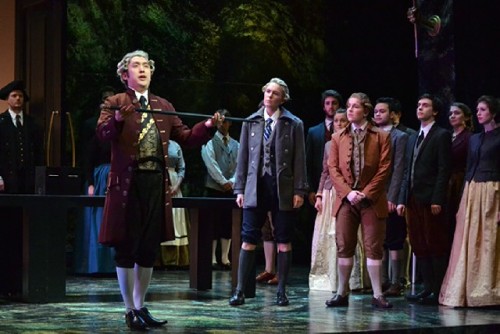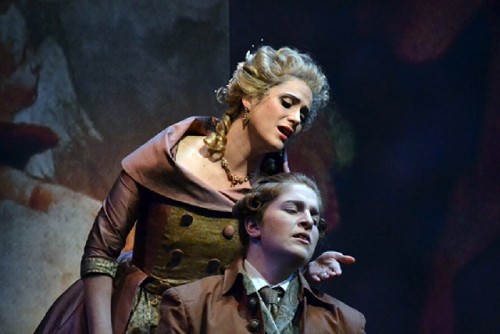B.U.'s Opera Institute Does Mozart
Final Work Combines Great Music with a Weak Story
By: David Bonetti - Apr 23, 2013
La Clemenza di Tito
Music by Wolfgang Amadeus Mozart
Libretto by Caterino Mazzolà, after Pietro Metastasio
Conductor: William Lumpkin
Stage director: Daniel Pelzig
Scenic designer: Martin Gjoni
Costume designer: Raissa Bretaña
Cast: Ji Eun Park (Vitellia), Lauren Lyles (Sesto), Jacquelyn Kress (Annio), Hee Jae Kim (Tito), Ruby White (Servilia), Erik Van Heyningen (Publio). (The opera is double-cast; this is the cast I heard Thursday, April 18.)
Boston University College of Fine Arts, School of Music Opera Institute and School of Theatre
Boston University Theatre
April 18-21
Wolfgang Amadeus Mozart is universally considered to be one of the greatest opera composers. His three masterpieces, “Le Nozze di Figaro,” Don Giovanni” and “Così fan Tutte” put profoundly human figures into character-revealing interaction, infusing operatic comedies with a proto-modernist psychology.
His final opera, “La Clemenza di Tito” (Titus’s Clemency), was a regression into the formulaic opera seria that dominated opera composing before he revolutionized the genre. Although the early music movement has demonstrated that those old formulas were capable of carrying more psychological complexity than convention had held them to be, his return to a genre that was considered old-fashioned comes as a surprise. There are explanations for why “Tito” didn’t delve more deeply into the human psyche – it was written on commission in 18 days to flatter an emperor on the occasion of his coronation - but it has to be counted as something of a dud among his works.
Of course, Mozart didn’t know that he would die only three months after its premiere leaving a less than masterpiece as his final work for the stage. (His Masonic opera, “Die Zauberflöte” (The Magic Flute), premiered after “Tito,” but he began to compose it earlier.)
Because Mozart was Mozart, however, even the quickly tossed off work has moments of genius - beautiful arias and ensembles abound, such as the justly famous showpiece aria, “Parto, parto, ma tu, ben mio,” and ensembles at the end of each of the two acts. The story is something else. Static and formulaic, it is dead as drama, the title giving everything away. If we already know that Tito is merciful, there is no suspense about whether he will pardon his friend Sesto from plotting his murder, the crux of the drama.
The opera opens with Vitellia, the daughter of the deposed Emperor Vitellius, in a fury. She has heard that the current Emperor, Tito, with whom she is in love, plans to marry Berenice, the daughter of the king of Judea, and she encourages Sesto, who loves her madly, to kill the Emperor, his best friend. (Just another day in the old Roman Empire.) Complications arise when Tito sends Berenice back to Judea and chooses Vitellia to be his new wife. In his mad love for Vitellia, Sesto has already set the Capitol on fire and killed a man he thinks is Tito. When Sesto is apprehended and condemned to death by the Senate, we don’t have to wonder whether Tito will forgive him. We already know that Tito is known for his mercy, he has demonstrated it a number of times – in his charity to the victims of the eruption of Vesuvius and in his easy renunciation of Servilia as his bride when he finds out that she and Annio are in love - and there is that title if we have any doubts.
B.U.’s School of Music Opera Institute did its best to bring the work to life, primarily by playing and singing the often marvelous music for all it is worth. Members of its student cast were audibly at different stages on the road to professionalism. Mezzo-sopranos Lauren Lyles and Jacquelyn Kress, singing the “trouser” roles of Sesto and Annio respectively, showed that they were farthest along the way. Lyles had a rich, full voice that reached its high notes effortlessly. Her rendition of “Parto,” was distinctive. Rather than singing it for its beauty alone, she used it as a dramatic vehicle. Kress’s low voice was particularly rich and resonant. Kress never quite convinced you that she was a he, but in her loose-limbed lanky boyishness, Lyles made you forget she was a woman. Also noteworthy was the pleasant tenor of Hee Jae Kim as Tito, although dramatically he had to try to make sense of an Emperor who was too good to be true in his willingness to forgive. In Tito, Mozart created one of his sweet-sounding tenor wimps, of which Don Ottavio in “Don Giovanni” is the best known, so there wasn’t much Kim could have done butch him up. By the way, Kim pronounced Italian clearly and accurately, a skill today’s opera singers-in-training often lack.
William Lumpkin led the orchestra with a light and brisk touch, in the style the early music movement has made de rigueur in music written before the Romantics.
The production was more problematic. The opera was set in a mishmash of period styles, the sets in a timeless neverland, the costumes in the period of the opera’s composition and the furnishings in the present. The metal-legged chairs looked as if they had been borrowed for the weekend from the lounge of a hotel on the Interstate. Surely, B.U. could have found something better. The primary set was a room with walls painted to resemble antico verde marble, the green veined marble that connotes luxury. When the scene switched, large panels bearing images from baroque paintings descended. That device worked, but the images on the panels were Christian, while the opera was set in the pagan past, one of several incongruities in Martin Gjoni’s set design that proved to be annoying over the length of the three-hour performance.
Although it was effective in its larger sense, Daniel Pelzig’s direction included some peculiar touches. The chorus tended to walk around like a bunch of zombies, and in the second act when they sing a hymn to Tito’s safety, they make weird hand gestures that look like some bad ideas borrowed from Peter Sellars. And having Sesto and Vitellia flop around on the floor during a heated duet is a dated cliché from the ‘80s. Surely an Empress-to-be (in her own mind) would have a sofa handy.
Still, doing such an opera was an ambitious undertaking for the Opera Institute, and it offered an entertaining evening to the public as it furthered its young performers on the road to professional careers.




